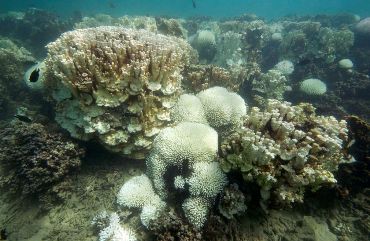 International marine scientists say the worst coral bleaching in more than a decade has struck reefs across the South-East Asian and Indian oceans in recent months.
International marine scientists say the worst coral bleaching in more than a decade has struck reefs across the South-East Asian and Indian oceans in recent months.
They say that the coral death could be the most damaging bleaching event ever recorded.
It has hit the area known as the Coral Triangle, which has more than 500 coral species making it the richest marine biodiversity zone on the planet.
But over the past six months, there have been some significant changes.
Andrew Baird, from the ARC Centre for Excellence for Coral Reef Studies, says the bleaching is far-reaching.
“A lot of reports have come in from the Andaman Sea – so Thailand down [to] Singapore, Malaysia – the scale is huge,” he said.
“It probably extends from the Western Indian Ocean, right across into the Coral Triangle and also there’s bleaching in the Philippines and it’s starting to get hot in the Pacific.
“So it looks like this event will be as big as the last global bleaching event which was 1998.”
Dr Baird has been working in Aceh on the boundary of the Coral Triangle. He says the impact there has been severe.
“What we’ve seen there is a bleaching event that was caused by hot water back in May and what we’ve documented is about 80 per cent of the Acropora, which is typically the most predominant coral species… are dead,” he said.
“There’s a cyclic event in the Indian Ocean called the Indian Ocean Dipole, which is similar to El Nino events, and [causes] warm water pools in the west of the Indian Ocean.
“So this is a natural cyclic event but almost certainly human-induced climate change is increasing the intensity of that event.”
Professor Ove Hoegh-Guldberg, also from the ARC and the director of the Global Change Institute at the University of Queensland, says it is one of the worst coral bleaching events to hit the South-East Asian region.
“It only takes a small change in sea temperature to push coral beyond what they can stand,” he said.
“So we’ve seen, over the past 20 years, repeated assaults on reefs and this one seems to be one that’s going to be up there with some of the most severe events seen in the South-East Asian region.”
“If you look at the satellite sea surface temperature measurements, they’re showing that seas are about one to three degrees warmer than the long-term averages for the region.
“And that if [the] ocean remains at it for a month or two months, is enough to cause reefs to experience severe coral mortality.”
‘Amazon of the oceans’
Tony Mohr, the manager of the climate change program at the Australian Conservation Foundation, says the same sort of bleaching is happening around the world.
“The bleaching that we’re seeing right now in the Coral Triangle area is symptomatic of other bleaching events that we’ve seen in other major reefs around Australia, and around the world,” he said.
“It’s really showing that climate change is not something that’s going to happen in the future – it’s something that’s affecting systems right now.
“In the Coral Triangle area, there are a lot of people who are dependant on the coral to maintain fisheries, and those fisheries support a lot of people for basic sustenance.
“Of course it will also have an impact on the species that exist on the corals and there’s a lot of different species – it’s commonly regarded as the Amazon of the oceans in that area.”
He says reducing greenhouse gas emissions will help to protect this coral life.
“We really need to make sure that we reduce greenhouse gas pollution,” he said.
“That’s the main driver for these bleaching events that are occurring more frequently than they once did.
“That’s the main thing that we need to do to protect their future, but we also need to make sure that ocean acidification, another impact of greenhouse gas emissions, is also reduced.”




